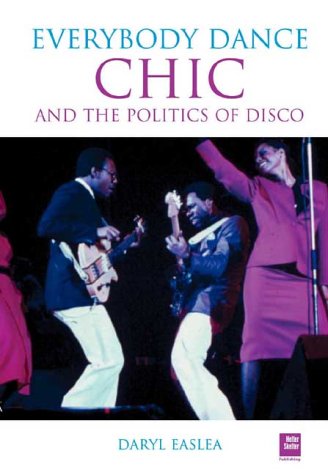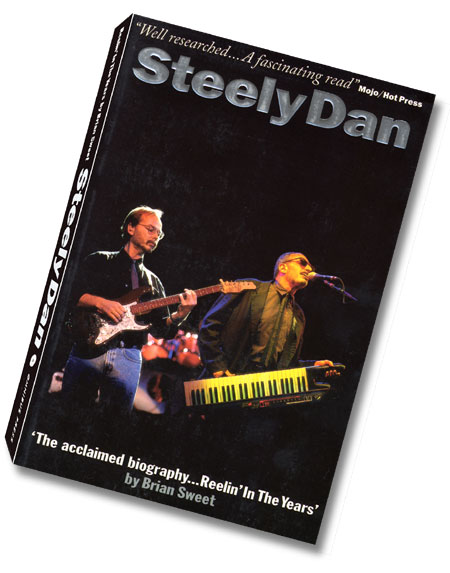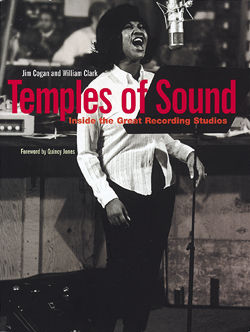| Author | Message |
Some Kool Books I've been checkin out: ...
Anybody got some other Kool books they're reading? These are some that I've been checkin' out(or re-reading) over the past year or so:          

... [Edited 10/19/05 11:47am] " I've got six things on my mind --you're no longer one of them." - Paddy McAloon, Prefab Sprout | |
- E-mail - orgNote -  Report post to moderator Report post to moderator |
Here's one somebody just hipped me to that i've got to get a hold of...

...TEMPLES OF SOUND: Inside the Great Recording Studios by Jim Cogan and William Clark; Foreword by Quincy Jones San Francisco: Chronicle Books, 2003. Softcover, 7.5" by 10", 224 pp. $24.95. ISBN 0-8118-3394-1. Temples of Sound: Inside the Great Recording Studios is a history of those US studios that were either the most influential in advancing the state of the art of American popular music from the late 1940s on—the "Golden Age"—or that made the records that were the most popular. In many cases, those were one and the same studio. The book is organized into 15 principal chapters, each dedicated to a particular recording operation and the artists most closely identified with it (footnote 1). The authors' approach is to blend business history, technical information, musical history and analysis, and social commentary. That approach works very well in avoiding the disconnected dryness that a single-minded focus on glorified equipment lists would bring. The authors are more concerned with how each studio as a whole—especially taking into account the human factor—contributed to the making of the records. The 15 studio chapters are organized on both geographical (west to east) and temporal (late 1940s to late 1970s) continua. The book starts off in California, with the early history of Capitol Records and the later construction of its own office building, which included studios. Next is United Western, famous for the Beach Boys' Pet Sounds sessions, and Sunset Sound, where the Doors' studio albums and James Taylor's Sweet Baby James were recorded. The focus then moves to Nashville (the Everly Brothers, Roy Orbison, later Elvis), Memphis (early Elvis, Jerry Lee Lewis, Otis Redding), and New Orleans (Fats Domino, Little Richard); then Chicago (Howlin' Wolf, Muddy Waters, Rolling Stones) and Detroit (Marvin Gaye, Supremes, Stevie Wonder); and, finally, New York (Ray Charles, Aretha Franklin, and Cream at Atlantic; Miles Davis, Bob Dylan, Barbra Streisand, and Simon and Garfunkle at Columbia), New Jersey (John Coltrane at Van Gelder), Philadelphia (Delfonics, Laura Nyro), and Miami (Bee Gees, Derek and the Dominos, Eagles). Each chapter begins with a large photograph of a recording artist associated with the studio, and then covers the origins and careers not only of the studio, but also, in many cases, the record labels that were the clients. There are many wonderful photographs (a precious few in period color), but the photographs do not predominate. Rather, it is the firsthand accounts of producers, engineers, and, in some cases, the recording artists, that make this book so rewarding. I consider myself well-read on the history of recording, but a few stories in Temples of Sound were new to me. Although I had been aware of the American Federation of Musicians' boycott of the recording industry in the early 1940s, I had not realized how that strike paradoxically paved the way for Capitol Records' early success, and the early career of Nat "King" Cole. Believing that the musicians were serious and would not back down, Capitol's owners rushed to record sides before the ban went into effect. Some of those songs, such as "Cow Cow Boogie" and "GI Jive," became hits both on their own merits, and owing to the lack of new releases from other labels (footnote 2). But as the AFM strike continued, Capitol beat the bushes for masters they could prove had been recorded before the ban. They bought two Nat "King" Cole sides from a local African-American independent label, and released them nationwide. Cole's later financial success (after the industry agreed to pay musicians royalties and the boycott was lifted) enabled Capitol to offer a home to Frank Sinatra, who had been let go by Columbia and had failed in a suicide attempt. These are just a few of the "ah-ha" moments in this book. An appendix recommends 12 classic recordings from each of the 15 studios—an admirable and welcome feature. I think that the decision to end the coverage in the late 1970s is a function of the writers' fascination with recording music as an exercise in holistic organicity (those may be code words for "analog"). Indeed, Temples of Sound can be viewed as a history of pop recording during the age of analog, open-reel magnetic tape. The first paragraph of the Introduction says it all: "Recording music in the studio used to be a romantic endeavor. Between the late 1940s and the late 1970s, players by and large were all in the same space at the same time, along with the engineer, who was piloting the whole deal." Digital multitrack studios in which one part can be piped in by ISDN network routers somehow don't seem to hold the writers' attention as much as does the room where Miles Davis recorded Kind of Blue, and Glenn Gould re-recorded the Goldberg Variations. Temples of Sound was a labor of love, but the writers' enthusiasm caused them to unleash a barrage of clichés and mixed metaphors. Also, a book about recording studios should not consistently misspell Bruce Swedien's last name as "Swedein," much less Michel Legrand's first name as "Michael." But a few minor shortcomings should not keep anyone from adding Temples of Sound to their library. This is a great book, and one that nearly all audiophiles and lovers of American popular music from the late 1940s on will immensely enjoy reading from cover to cover, and then having on hand for reference. I'm sure you'll get many kicks out of it, as well as learn a lot. Highly recommended.—John Marks http://stereophile.com/fe...04temples/ =-=-=-=-=-=-=-=-=-=-=-=-=-=-=-= An audio interview with the authors can be found here: http://www.npr.org/templa...Id=1257403 tA  Tribal Disorder Tribal Disorder
http://www.soundclick.com...dID=182431 "Ya see, we're not interested in what you know...but what you are willing to learn. C'mon y'all." | |
- E-mail - orgNote -  Report post to moderator Report post to moderator |
...
... " I've got six things on my mind --you're no longer one of them." - Paddy McAloon, Prefab Sprout | |
- E-mail - orgNote -  Report post to moderator Report post to moderator |
busy reader! | |
- E-mail - orgNote -  Report post to moderator Report post to moderator |
paligap said: ...
... NP. Guess that's why you're the I'm at the alter to get my SOUL saved. tA  Tribal Disorder Tribal Disorder
http://www.soundclick.com...dID=182431 "Ya see, we're not interested in what you know...but what you are willing to learn. C'mon y'all." | |
- E-mail - orgNote -  Report post to moderator Report post to moderator |
Pali, google image search would be lost without you! paligap said:  How's that one? | |
- E-mail - orgNote -  Report post to moderator Report post to moderator |
Yeah I read and collect music bios, label histories, instrument studies, songbooks other musicologaical books.
Got the Stevie book open right now! That Shorter bio is on the "MUST GET" list as is THE LAST MILES(regarding the WARNERS recording) 
I've already read MILES BEYOND and the Philly book. The Zawinul is a revelation but the Marvin (already read the Ritz book) Steely Dan, Chic/disco and Jimi book are on a low-priority level. I'm also reading BOOGALOO! by Arthur Kempton. 
There's a book called HIGHER GROUND which broke down the rise and fall of soul, with a three-pronged focus on Aretha, Curtis and Stevie. It's out in trade paperback, but I'm rummaging the remainder and discount books section for a hardcover copy. [Edited 10/19/05 12:33pm] test | |
- E-mail - orgNote -  Report post to moderator Report post to moderator |
theAudience said: Here's one somebody just hipped me to that i've got to get a hold of...

...TEMPLES OF SOUND: Inside the Great Recording Studios by Jim Cogan and William Clark; Foreword by Quincy Jones San Francisco: Chronicle Books, 2003. Softcover, 7.5" by 10", 224 pp. $24.95. ISBN 0-8118-3394-1. Temples of Sound: Inside the Great Recording Studios is a history of those US studios that were either the most influential in advancing the state of the art of American popular music from the late 1940s on—the "Golden Age"—or that made the records that were the most popular. In many cases, those were one and the same studio. The book is organized into 15 principal chapters, each dedicated to a particular recording operation and the artists most closely identified with it (footnote 1). The authors' approach is to blend business history, technical information, musical history and analysis, and social commentary. That approach works very well in avoiding the disconnected dryness that a single-minded focus on glorified equipment lists would bring. The authors are more concerned with how each studio as a whole—especially taking into account the human factor—contributed to the making of the records. The 15 studio chapters are organized on both geographical (west to east) and temporal (late 1940s to late 1970s) continua. The book starts off in California, with the early history of Capitol Records and the later construction of its own office building, which included studios. Next is United Western, famous for the Beach Boys' Pet Sounds sessions, and Sunset Sound, where the Doors' studio albums and James Taylor's Sweet Baby James were recorded. The focus then moves to Nashville (the Everly Brothers, Roy Orbison, later Elvis), Memphis (early Elvis, Jerry Lee Lewis, Otis Redding), and New Orleans (Fats Domino, Little Richard); then Chicago (Howlin' Wolf, Muddy Waters, Rolling Stones) and Detroit (Marvin Gaye, Supremes, Stevie Wonder); and, finally, New York (Ray Charles, Aretha Franklin, and Cream at Atlantic; Miles Davis, Bob Dylan, Barbra Streisand, and Simon and Garfunkle at Columbia), New Jersey (John Coltrane at Van Gelder), Philadelphia (Delfonics, Laura Nyro), and Miami (Bee Gees, Derek and the Dominos, Eagles). Each chapter begins with a large photograph of a recording artist associated with the studio, and then covers the origins and careers not only of the studio, but also, in many cases, the record labels that were the clients. There are many wonderful photographs (a precious few in period color), but the photographs do not predominate. Rather, it is the firsthand accounts of producers, engineers, and, in some cases, the recording artists, that make this book so rewarding. I consider myself well-read on the history of recording, but a few stories in Temples of Sound were new to me. Although I had been aware of the American Federation of Musicians' boycott of the recording industry in the early 1940s, I had not realized how that strike paradoxically paved the way for Capitol Records' early success, and the early career of Nat "King" Cole. Believing that the musicians were serious and would not back down, Capitol's owners rushed to record sides before the ban went into effect. Some of those songs, such as "Cow Cow Boogie" and "GI Jive," became hits both on their own merits, and owing to the lack of new releases from other labels (footnote 2). But as the AFM strike continued, Capitol beat the bushes for masters they could prove had been recorded before the ban. They bought two Nat "King" Cole sides from a local African-American independent label, and released them nationwide. Cole's later financial success (after the industry agreed to pay musicians royalties and the boycott was lifted) enabled Capitol to offer a home to Frank Sinatra, who had been let go by Columbia and had failed in a suicide attempt. These are just a few of the "ah-ha" moments in this book. An appendix recommends 12 classic recordings from each of the 15 studios—an admirable and welcome feature. I think that the decision to end the coverage in the late 1970s is a function of the writers' fascination with recording music as an exercise in holistic organicity (those may be code words for "analog"). Indeed, Temples of Sound can be viewed as a history of pop recording during the age of analog, open-reel magnetic tape. The first paragraph of the Introduction says it all: "Recording music in the studio used to be a romantic endeavor. Between the late 1940s and the late 1970s, players by and large were all in the same space at the same time, along with the engineer, who was piloting the whole deal." Digital multitrack studios in which one part can be piped in by ISDN network routers somehow don't seem to hold the writers' attention as much as does the room where Miles Davis recorded Kind of Blue, and Glenn Gould re-recorded the Goldberg Variations. Temples of Sound was a labor of love, but the writers' enthusiasm caused them to unleash a barrage of clichés and mixed metaphors. Also, a book about recording studios should not consistently misspell Bruce Swedien's last name as "Swedein," much less Michel Legrand's first name as "Michael." But a few minor shortcomings should not keep anyone from adding Temples of Sound to their library. This is a great book, and one that nearly all audiophiles and lovers of American popular music from the late 1940s on will immensely enjoy reading from cover to cover, and then having on hand for reference. I'm sure you'll get many kicks out of it, as well as learn a lot. Highly recommended.—John Marks http://stereophile.com/fe...04temples/ =-=-=-=-=-=-=-=-=-=-=-=-=-=-=-= An audio interview with the authors can be found here: http://www.npr.org/templa...Id=1257403 tA  Tribal Disorder Tribal Disorder
http://www.soundclick.com...dID=182431 ohhhyeah i saw this a couple of years ago, but spaced on it. Should be in DISCOUNT section by now! test | |
- E-mail - orgNote -  Report post to moderator Report post to moderator |
PFunkjazz said: There's a book called HIGHER GROUND which broke down the rise and fall of soul, with a three-pronged focus on Aretha, Curtis and Stevie. It's out in trade paperback, but I'm rummaging the remainder and discount books section for a hardcover copy. [Edited 10/19/05 12:33pm] Yeah, I wanna check that one out, too...I liked Craig Werner's last Book, "A Change is Gonna Come", but that one never came out in hardback I'd like to see what Cole says about Mile's Warner years.... ... " I've got six things on my mind --you're no longer one of them." - Paddy McAloon, Prefab Sprout | |
- E-mail - orgNote -  Report post to moderator Report post to moderator |
paligap said I'd like to see what Cole says about Mile's Warner years.... ... I skimmedit. He's a lot more positive than I am. Could be a major paradigm shift for me. test | |
- E-mail - orgNote -  Report post to moderator Report post to moderator |
RipHer2Shreds said: Pali, google image search would be lost without you!
paligap said:  How's that one? It's good; well-written. I lost interest towards the end, but that's because my interest in Philly Soul wanes. I want the "real dirt" from Gamble & Huff. There were many instances when they simply would not talk to the writer. test | |
- E-mail - orgNote -  Report post to moderator Report post to moderator |
RipHer2Shreds said: Pali, google image search would be lost without you!
paligap said:  How's that one? I really liked that one! It's essentially about the big three, Gamble, Huff, and Thom Bell, but it's a good overall history of the label..the positive and the negative... ... " I've got six things on my mind --you're no longer one of them." - Paddy McAloon, Prefab Sprout | |
- E-mail - orgNote -  Report post to moderator Report post to moderator |
I've had that hendrix book for a couple years, but never got around to reading it until hurricane George killed the power around here and i started reading again. Guess i got on a Jimi kick cause I bought the cross book and reread several of the other Jimi books I have | |
- E-mail - orgNote -  Report post to moderator Report post to moderator |
I wanna check this one out:
 a psychotic is someone who just figured out what's going on | |
- E-mail - orgNote -  Report post to moderator Report post to moderator |
Don´t forget Divided Soul by David Ritz ...it´s a Marvin Gaye biography...onbe of the best biographies ever... " I´d rather be a stank ass hoe because I´m not stupid. Oh my goodness! I got more drugs! I´m always funny dude...I´m hilarious! Are we gonna smoke?" | |
- E-mail - orgNote -  Report post to moderator Report post to moderator |
KoolEaze said: Don´t forget Divided Soul by David Ritz ...it´s a Marvin Gaye biography...onbe of the best biographies ever...
Yeah, Divided Soul has always been the best book on Marvin...this other RED one above (in the original post) is specifically about the making of the What's Going On album....it just concentrates on how the whole album came together... ... [Edited 10/20/05 8:20am] " I've got six things on my mind --you're no longer one of them." - Paddy McAloon, Prefab Sprout | |
- E-mail - orgNote -  Report post to moderator Report post to moderator |
Read the Marvin book. David Ritz book and the book by Marvin's brother are the best one's. I'll have to check out the others. | |
- E-mail - orgNote -  Report post to moderator Report post to moderator |
Stax said: I wanna check this one out:
 ooh me too. | |
- E-mail - orgNote -  Report post to moderator Report post to moderator |
 New topic
New topic Printable
Printable